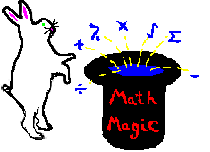



When we see numbers in everyday life, we always see numbers that are composed of the digits 0 through 9. This is base 10. For instance, take the number 1234. When you see this number you see:
(10)3 x 1 + (10)2 x 2 + (10)1 x 3 + (10)0 x 4
This is how you manipulate numbers in base 10. If you were in a different base, 'b', then the highest digit in the base is 'b' - 1, and any numbers would be represented by the following:
(b)n x a + ... + (b)1 x a' + (b)0 x a''. where a, a', and a'' represent different digits.
The lowest base is of course 2, since the only numbers you can have are 0 and 1.
In number sense, we see problems that deal with bases and there are many methods we can use.
(**) Changing from base b to 10 (*PDF*) | |
|
(**) Changing from base 10 to b (*PDF*) | |
|
(**) Changing from base 2 to 4 (*PDF*) | |
|
(**) Changing from base 2 to 8 (*PDF*) | |
|
(**) Changing from base 3 to 9 (*PDF*) | |
|
(**) Adding 2 numbers in a different base (*PDF*) | |
|
(***) Changing from a base 10 decimal/fraction to a base b decimal (*PDF*) | |
|
(***) Changing from a base b decimal to a base 10 decimal/fraction (*PDF*) | |
|
(***) Multiplying 2 numbers in a different base (*PDF*) | |
(***) Finding the remainder when nb is divided by (b-1) (*PDF*) |